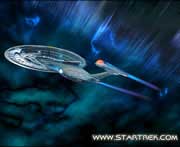Star trek criteria

Star trekking: space voyagers should be one big family. <br>© Startrek.com <br>
Interstellar travellers should be “motivated, tolerant and nice”.
One hundred and sixty fertile, motivated, English speakers could make it to distant stars, researchers have worked out. But generations down the line, returning voyagers may speak an alien tongue.
Travel to planets orbiting other stars will soon be technically possible, the meeting of the American Association for the Advancement of Sciences in Boston heard last week. But the 200-year odyssey will require a certain kind of crew.
Sci-fi teams of frozen humans and cyborgs “didn’t seem likely to make it”, anthropologist John Moore of the University of Florida in Gainsville told the meeting. Families, he reckons, are a better basis for long-term travel.
Moore has worked out the smallest group that could maintain a crew over 8-10 generations. Each person must have a choice of ten possible partners, his population simulation calculates. If women had children late in life, the crew could drop to 80.
Language of intergalactic love
Prospective couples should woo in English, said linguist Sarah Thomason of the University of Michigan in Ann Arbor. Global politics would probably dictate a multinational mix, but the current international language is the most obvious choice for conversation.
But if the journey takes 500 years, home and ship “won’t be able to talk to each other”, Thomason predicts. Down-to-Earth words like ’horse’ and ’truck’ would have no meaning on board, and the slang of interstellar adolescents would diverge from Earth-speak. The crew would have to be beamed language lessons, Thomason said.
Temperament is also critical. “You want motivated, tolerant, nice people,” said Moore. This should ensure future generations don’t lose interest in the mission and head for the nearest hospitable asteroid belt. Whether the band would actually get on would be more a matter of luck, the researchers conceded.
The exercise is not science fiction, explained space scientist Geoffrey Landis of the NASA Glenn Research Center, Cleveland. Several ways to reach other solar systems have been proposed in recent years. These include using a laser beam projected from Earth to push a vast space sail. Such a ship might travel at 30,000 kilometres per second – around a tenth of light speed.
“There’s actually been some testing done,” revealed Landis: “Ultimately, this is going to happen.” No one is taking crew applications yet, however.
Media Contact
All latest news from the category: Physics and Astronomy
This area deals with the fundamental laws and building blocks of nature and how they interact, the properties and the behavior of matter, and research into space and time and their structures.
innovations-report provides in-depth reports and articles on subjects such as astrophysics, laser technologies, nuclear, quantum, particle and solid-state physics, nanotechnologies, planetary research and findings (Mars, Venus) and developments related to the Hubble Telescope.
Newest articles

Silicon Carbide Innovation Alliance to drive industrial-scale semiconductor work
Known for its ability to withstand extreme environments and high voltages, silicon carbide (SiC) is a semiconducting material made up of silicon and carbon atoms arranged into crystals that is…

New SPECT/CT technique shows impressive biomarker identification
…offers increased access for prostate cancer patients. A novel SPECT/CT acquisition method can accurately detect radiopharmaceutical biodistribution in a convenient manner for prostate cancer patients, opening the door for more…

How 3D printers can give robots a soft touch
Soft skin coverings and touch sensors have emerged as a promising feature for robots that are both safer and more intuitive for human interaction, but they are expensive and difficult…





















